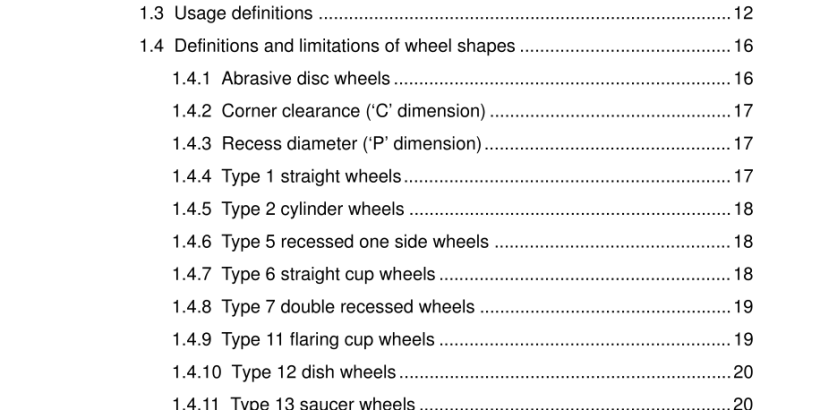ANSI B7.1-2000 pdf download.Safety Requirements for the Use, Care and Protection of Abrasive Wheels
1 .1 Scope
This safety standard sets forth requirements for the safe use, care and protection of abra- sive wheels and the machines for which they are designed. Included in this standard are the requirements for safety guards, flanges, chucks and proper storage, handling and mounting techniques. Exclusions from this standard are natural sand- stone, pulpstone and coated abrasive prod- ucts. This standard also does not apply to machines using loose abrasives.
1.2 Definitions
1.2.1 abrasive wheel/grinding wheel:* An abrasive wheel is a grinding tool consisting of abrasive grains held together by organic or inorganic bonds. Diamond and reinforced wheels are included under this definition.
1.2.44 inorganic bonded wheels: Inorganic wheels are bonded by means of inorganic material such as clay, glass, porcelain sodium silicate, magnesium oxychloride, or metal. Wheels bonded with clay, glass, porcelain or related ceramic materials are characterized as “vitrified bonded wheels.”
1.2.45 installer:* An installer is an individual, partnership or corporation that is responsible for the placement and preparation for use of a grinding machine.
1.2.46 integrator: A supplier that designs, provides, manufactures or assembles a ma- chine, its associated machines or equipment, the safeguarding, control interfaces, and in- terconnections of the control system into a machine production system. (See supplier.)
1.2.47 interlock: A means or device that allows a hazardous condition to exist only when a predetermined set of conditions is met.
1.2.48 machine cycle: A machine cycle is the period of time that encompasses the grind cycle and all other machine functions required in the operation before and after the grind cycle. Loading and unloading of the part either manually or automatically may be included in the cycle.
1.2.49 machine supplier: (a) Any individual, person, partnership, corporation or other form of enterprise engaged in the development and/ or manufacture of any type of machine which uses an abrasive wheel. (b) One who con- verts, changes or otherwise alters the original design of such machines.
1.2.50 maintenance: To keep in an existing state (of repair).
1.2.51 manufacturer:* (a) machine manufac- turer — Any individual, partnership, corpora- tion, or other form of enterprise which is en- gaged in the development, manufacture, or rebuilding of any type of grinding machine that falls within the scope of this standard. (b)wheel manufacturer — Any individual, part- nership, corporation or other form of enter- prise which manufacturers any kind of abra- sive wheel or which alters or repairs, other than normal truing or dressing, an abrasive wheel.
1 .3.1 7 regulating wheel: In centerless grind- ing, the workpiece is introduced between two wheels, the grinding wheel and the regulating wheel, both rotating in the same direction but at different speeds. At the same time, the workpiece is supported from below by a fixed work-rest blade. The grinding force compo- nent acting in the horizontal direction forces the part against the regulating wheel, which will control the part rotation. The part will rotate at the speed of the regulating wheel, times the ratio of the regulating wheel diam- eter over the part diameter. Regulating wheels typically operate at speeds of 1 0 to 600 RPM. The regulating wheel controls the rotational speed of the workpiece and is not considered a grinding wheel and therefore is not subject to the design limitations associated with a grinding wheel.
Definition: Type 1 straight wheels have diameter, thick- ness and hole size dimensions and grinding should be performed on the periphery. This does not preclude their use for applications such as shoulder contour and form grinding where it is recognized that a limited amount of side grinding will be performed. Extreme cau- tion should be exercised not to use excessive side pressure. Type 1 wheels shall be mounted between equal flanges of the appropriate de- sign as specified in section 5, page 72.ANSI B7.1-2000 pdf download
